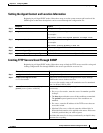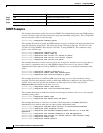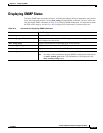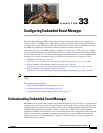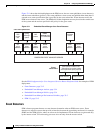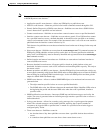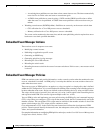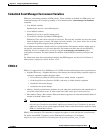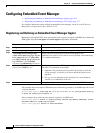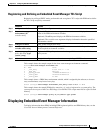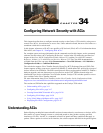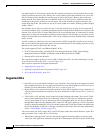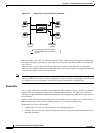
33-5
Catalyst 3750 Switch Software Configuration Guide
OL-8550-09
Chapter 33 Configuring Embedded Event Manager
Understanding Embedded Event Manager
Embedded Event Manager Environment Variables
EEM uses environment variables in EEM policies. These variables are defined in a EEM policy tool
command language (TCL) script by running a CLI command and the event manager environment
command.
• User-defined variables
Defined by the user for a user-defined policy.
• Cisco-defined variables
Defined by Cisco for a specific sample policy.
• Cisco built-in variables (available in EEM applets)
Defined by Cisco and can be read-only or read-write. The read-only variables are set by the system
before an applet starts to execute. The single read-write variable, _exit_status, allows you to set the
exit status for policies triggered from synchronous events.
Cisco-defined environment variables and Cisco system-defined environment variables might apply to
one specific event detector or to all event detectors. Environment variables that are user-defined or
defined by Cisco in a sample policy are set by using the event manager environment global
configuration command. You must defined the variables in the EEM policy before you register the
policy.
For information about the environmental variables that EEM supports, see the Cisco IOS Network
Management Configuration Guide, Release 12.4T.
EEM 3.2
EEM 3.2 is supported in Cisco IOS Release 12.2(52)SE and later and introduces these event detectors:
• Neighbor Discovery—Neighbor Discovery event detector provides the ability to publish a policy to
respond to automatic neighbor detection when:
–
a Cisco Discovery Protocol (CDP) cache entry is added, deleted, or updated.
–
a Link Layer Discovery Protocol (LLDP) cache entry is added, deleted or updated.
–
an interface link status changes.
–
an interface line status changes.
• Identity—Identity event detector generates an event when AAA authorization and authentication is
successful, when failure occurs, or after normal user traffic on the port is allowed to flow.
• Mac-Address-Table—Mac-Address-Table event detector generates an event when a MAC address is
learned in the MAC address table.
Note The Mac-Address-Table event detector is supported only on switch platforms and can be used
only on Layer 2 interfaces where MAC addresses are learned. Layer 3 interfaces do not learn
addressers routers do not usually support the MAC address-table infrastructure needed to notify
EEM of a learned MAC address.
EEM 3.2 also introduces CLI commands to support the applets to work with the new event detectors.
For details about EEM 3.2 features, see the Embedded Event Manager 3.2 document:
http://www.cisco.com/en/US/docs/ios/netmgmt/configuration/guide/nm_eem_3.2.html



